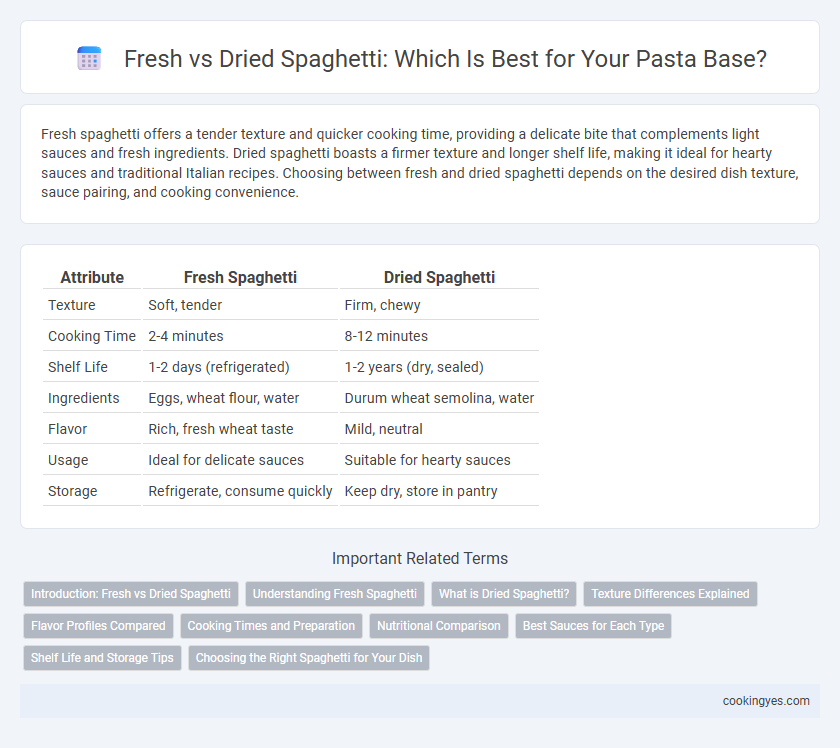Fresh spaghetti offers a tender texture and quicker cooking time, providing a delicate bite that complements light sauces and fresh ingredients. Dried spaghetti boasts a firmer texture and longer shelf life, making it ideal for hearty sauces and traditional Italian recipes. Choosing between fresh and dried spaghetti depends on the desired dish texture, sauce pairing, and cooking convenience.
Table of Comparison
| Attribute | Fresh Spaghetti | Dried Spaghetti |
|---|---|---|
| Texture | Soft, tender | Firm, chewy |
| Cooking Time | 2-4 minutes | 8-12 minutes |
| Shelf Life | 1-2 days (refrigerated) | 1-2 years (dry, sealed) |
| Ingredients | Eggs, wheat flour, water | Durum wheat semolina, water |
| Flavor | Rich, fresh wheat taste | Mild, neutral |
| Usage | Ideal for delicate sauces | Suitable for hearty sauces |
| Storage | Refrigerate, consume quickly | Keep dry, store in pantry |
Introduction: Fresh vs Dried Spaghetti
Fresh spaghetti offers a tender texture and quicker cooking time, making it ideal for delicate sauces and recipes emphasizing freshness. Dried spaghetti provides a firmer bite and longer shelf life, suitable for hearty sauces and convenient storage. Choosing between fresh and dried spaghetti depends on recipe requirements, texture preference, and cooking time availability.
Understanding Fresh Spaghetti
Fresh spaghetti offers a tender texture and quicker cooking time compared to dried spaghetti, making it ideal for delicate sauces and recipes requiring a soft bite. Made from high-quality semolina flour and water, fresh spaghetti retains more moisture, enhancing flavor absorption and providing a superior mouthfeel. While it has a shorter shelf life, fresh spaghetti's versatility and richness in texture contribute to authentic Italian pasta dishes.
What is Dried Spaghetti?
Dried spaghetti is pasta made from durum wheat semolina that has been shaped into long, thin strands and dried at low temperatures to remove moisture, extending its shelf life for months or even years. It offers a firmer texture and is ideal for absorbing hearty sauces, making it a versatile staple in Italian cuisine. Unlike fresh spaghetti, dried spaghetti requires longer cooking times but provides a consistent al dente bite preferred in many traditional pasta dishes.
Texture Differences Explained
Fresh spaghetti offers a tender, silky texture due to its higher moisture content and shorter drying process, making it ideal for delicate sauces. Dried spaghetti, with a denser and firmer bite, results from low moisture and slow dehydration, providing better hold in robust, hearty sauces. Texture differences significantly impact dish outcomes, with fresh pasta delivering softness and dried pasta contributing a pleasantly al dente chew.
Flavor Profiles Compared
Fresh spaghetti boasts a tender texture and a delicate, slightly sweet flavor due to its higher moisture content and fresh ingredients. Dried spaghetti offers a firmer bite and a more concentrated wheat taste, resulting from its low moisture and extended drying process. The choice between fresh and dried spaghetti significantly influences the overall flavor profile and texture of pasta dishes.
Cooking Times and Preparation
Fresh spaghetti cooks rapidly, typically in 2 to 4 minutes, offering a tender texture ideal for delicate sauces. Dried spaghetti requires longer cooking times, usually 8 to 12 minutes, providing a firmer bite preferred in robust pasta dishes. Preparation of fresh spaghetti involves immediate cooking or refrigeration, while dried spaghetti benefits from extended shelf life and easy storage.
Nutritional Comparison
Fresh spaghetti contains higher moisture content and retains more natural nutrients such as B vitamins and antioxidants compared to dried spaghetti, which undergoes heat processing that can reduce these elements. Dried spaghetti has a longer shelf life and a slightly higher protein concentration due to water loss, making it a more concentrated source of carbohydrates and fiber per serving. Both types provide essential nutrients like iron and folic acid, but fresh spaghetti often offers better texture and digestibility, influencing nutrient absorption.
Best Sauces for Each Type
Fresh spaghetti's tender texture pairs best with light, delicate sauces such as garlic and olive oil, fresh tomato, or seafood-based sauces that complement its subtle flavor. Dried spaghetti, known for its firm bite and ability to hold shape, is ideal for robust sauces like classic marinara, Bolognese, or hearty meat ragus that cling well to the pasta strands. Selecting the appropriate spaghetti type enhances sauce adhesion and overall dish harmony, maximizing flavor and texture balance.
Shelf Life and Storage Tips
Fresh spaghetti has a shelf life of about 2 to 3 days when refrigerated and should be stored in an airtight container to maintain moisture and prevent spoilage. Dried spaghetti, with a shelf life of up to 2 years when stored in a cool, dry place, offers convenience and long-term storage without refrigeration. Proper storage for dried spaghetti involves keeping it away from humidity and heat to preserve its texture and flavor.
Choosing the Right Spaghetti for Your Dish
Fresh spaghetti offers a tender texture and subtle flavor ideal for light sauces like olive oil or tomato-based recipes, enhancing delicate pasta dishes. Dried spaghetti, with its firm structure and longer shelf life, excels in robust, hearty sauces such as Bolognese or carbonara, providing a satisfying bite. Selecting the right spaghetti depends on the sauce's intensity and desired texture, ensuring perfect harmony between pasta and flavor.
Fresh spaghetti vs Dried spaghetti for Pasta base Infographic

 cookingyes.com
cookingyes.com